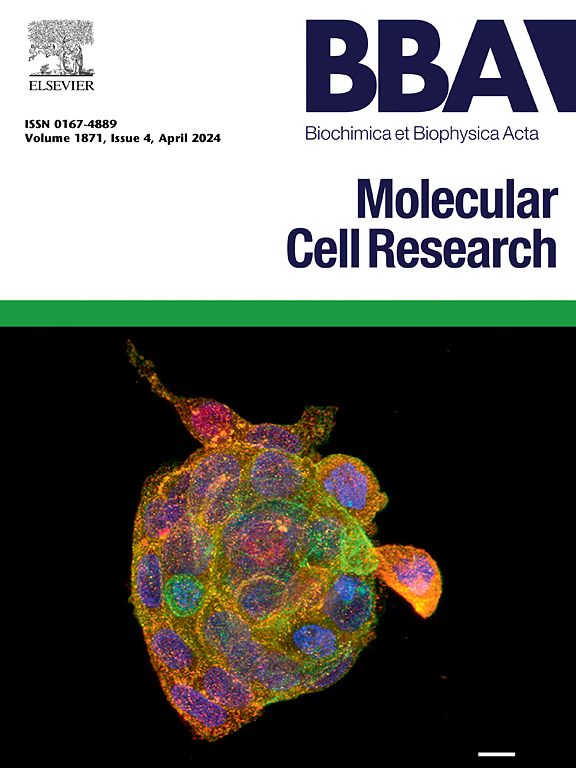癌相关成纤维细胞衍生外泌体lncRNA RORA-AS1通过IFITM1/STAT轴促进口腔鳞状细胞癌的放疗耐药。
IF 3.7
2区 生物学
Q1 BIOCHEMISTRY & MOLECULAR BIOLOGY
Biochimica et biophysica acta. Molecular cell research
Pub Date : 2025-06-28
DOI:10.1016/j.bbamcr.2025.120015
引用次数: 0
摘要
我们之前使用lncRNA芯片在癌相关成纤维细胞(CAFs)中鉴定了差异表达的lncRNA。然而,cafs衍生的lncRNAs调控口腔鳞状细胞癌(OSCC)放疗耐药的分子机制尚不清楚。本研究发现,lncRNA RORA-AS1 (RORA-AS1)在CAFs、源自CAFs的外泌体(CAFs-exo)和OSCC组织中显著过表达。值得注意的是,基于rora - as1的nomogram显示了对OSCC患者生存的强大预测能力。此外,RORA-AS1与CAF浸润呈显著正相关。在体外实验中,在8 Gy x射线照射下,CAFs-CM和CAFs-exo均能增强Cal27细胞的增殖,上调RORA-AS1和IFITM1的表达,同时抑制细胞凋亡。RORA-AS1敲低可减轻CAFs-exo诱导的Cal27细胞放疗耐药。在机制上,RORA-AS1敲低导致Cal27细胞中p-STAT1、p21和p53的表达增加,同时p-STAT3和IFITM1的水平降低。RIP实验证实了RORA-AS1与IFITM1 RNA复合物之间的物理关联。在体内实验中,在放疗条件下,CAFs-exo增强肿瘤生长和RORA-AS1和IFITM1的表达,而RORA-AS1的敲低则减轻了这种作用。综上所述,cafa衍生的外泌体RORA-AS1通过激活IFITM1/STAT信号级联促进OSCC的放疗耐药。这些发现确定了RORA-AS1作为OSCC诊断和治疗的潜在生物标志物。本文章由计算机程序翻译,如有差异,请以英文原文为准。
Carcinoma-associated fibroblast-derived exosomes lncRNA RORA-AS1 facilitates radiotherapy resistance of oral squamous cell carcinoma through the IFITM1/STAT axis
We previously identified differentially expressed lncRNAs in carcinoma-associated fibroblasts (CAFs) using a lncRNA Chip. However, the molecular mechanisms by which CAFs-derived lncRNAs regulate radiotherapy resistance in Oral squamous cell carcinoma (OSCC) remain poorly understood. This study found that lncRNA RORA-AS1 (RORA-AS1) was markedly overexpressed in CAFs, exosomes derived from CAFs (CAFs-exo), and OSCC tissues. Notably, a RORA-AS1-based nomogram demonstrated robust predictive performance for OSCC patient survival. Moreover, RORA-AS1 showed a significant positive correlation with CAF infiltration. In in vitro experiments, both CAFs-CM and CAFs-exo enhanced Cal27 cell proliferation and upregulated RORA-AS1 and IFITM1 expression, while concurrently inhibiting apoptosis, upon exposure to 8 Gy X-rays irradiation. RORA-AS1 Knockdown mitigated the radiotherapy resistance induced by CAFs-exo in Cal27 cells. Mechanistically, RORA-AS1 knockdown led to increased expression of p-STAT1, p21, and p53, alongside decreased levels of p-STAT3 and IFITM1 in Cal27 cells. RIP assay confirmed the physical association between RORA-AS1 and the IFITM1 RNA complex. In in vivo experiments, CAFs-exo enhanced tumor growth and RORA-AS1 and IFITM1 expression under radiotherapy conditions, which was mitigated by RORA-AS1 knockdown. In conclusion, CAF-derived exosome RORA-AS1 facilitates radiotherapy resistance in OSCC by activating the IFITM1/STAT signaling cascade. These findings identify RORA-AS1 as a potential biomarker for the diagnosis and treatment of OSCC.
求助全文
通过发布文献求助,成功后即可免费获取论文全文。
去求助
来源期刊
CiteScore
10.00
自引率
2.00%
发文量
151
审稿时长
44 days
期刊介绍:
BBA Molecular Cell Research focuses on understanding the mechanisms of cellular processes at the molecular level. These include aspects of cellular signaling, signal transduction, cell cycle, apoptosis, intracellular trafficking, secretory and endocytic pathways, biogenesis of cell organelles, cytoskeletal structures, cellular interactions, cell/tissue differentiation and cellular enzymology. Also included are studies at the interface between Cell Biology and Biophysics which apply for example novel imaging methods for characterizing cellular processes.

 求助内容:
求助内容: 应助结果提醒方式:
应助结果提醒方式:


